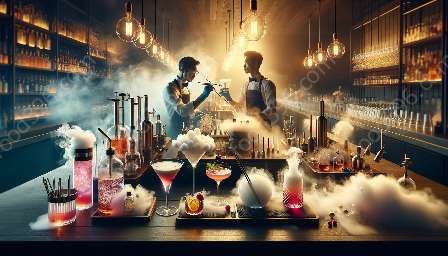Molecular mixology has revolutionized the way we think about cocktails. The use of cutting-edge techniques and ingredients has allowed mixologists to push the boundaries of traditional bartending and create visually stunning and delicious drinks.
Understanding Molecular Mixology
Molecular mixology is the practice of using scientific principles and techniques to create innovative and visually appealing cocktails. This approach involves a deep understanding of the chemical and physical properties of ingredients, allowing mixologists to manipulate them in new and exciting ways.
One of the key components of molecular mixology is the use of emulsification. This process involves combining two or more liquids that are normally immiscible, such as oil and water, to create a stable and visually stunning mixture. Emulsification is a crucial technique in molecular mixology, as it allows mixologists to create unique textures and flavors in their cocktails.
Molecular Mixology Techniques
There are several techniques used in molecular mixology to create visually appealing cocktails:
- Spherification: This technique involves using sodium alginate and calcium chloride to create spheres of liquid that burst in the mouth, providing an exciting and unexpected experience for the drinker.
- Foaming: By using techniques such as nitrous oxide chargers, mixologists can create foams from various cocktail ingredients, adding a visually appealing and luxurious element to the drink.
- Gelification: This technique transforms liquid ingredients into gels, allowing mixologists to create unique textures and presentations in their cocktails.
- Smoking: Infusing cocktails with smoke adds a theatrical element and enhances the aroma and flavor of the drink, contributing to the overall visual and sensory experience.
Compatibility with Emulsification
Emulsification plays a crucial role in molecular mixology, as it allows mixologists to create stable and visually appealing mixtures of liquids that would not normally combine. By understanding the principles of emulsification, mixologists can effectively incorporate this technique into their cocktail creations, enhancing both the visual and gustatory aspects of the drinks.
When emulsification is used in combination with other molecular mixology techniques, such as spherification or foaming, it can elevate the overall presentation and sensory experience of the cocktail. For example, emulsifying a flavored oil with a cocktail base before spherification can create visually stunning and flavorful spheres that add an element of surprise and delight to the drink.
Conclusion
Molecular mixology techniques offer endless opportunities for creating visually appealing cocktails that engage all the senses. By understanding and mastering the principles of emulsification and other innovative techniques, mixologists can push the boundaries of traditional bartending and offer customers an extraordinary drinking experience.

